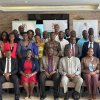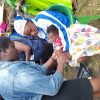Exposure to new technologies greatly impacts on sesame farmers in Northern Uganda

 Hellen Ogwal is the Chairperson of Agikdak Farmers Group in Agikdak village Amolatar district in Northern Uganda. Although she has been cultivating sesame and other crops in her village for over 20 years, she had never been able to harness the potential of the resource adequately due to low yield harvests and poor market for crops in her community. With limited crop farming knowledge and poor storage facilities for produce, most of her agricultural products were ruined by the increasing drought in the district and devastating crop pests and diseases. According to Hellen, the local sesame varieties they planted on large acreage (over 20 acres) yielded less than what one would expect from such a large field. The crop often succumbed to gall midge and webworm on top of being highly vulnerable to the climatic changes in the region. This posed a consistent threat to produce, highly affecting its quality.
Hellen Ogwal is the Chairperson of Agikdak Farmers Group in Agikdak village Amolatar district in Northern Uganda. Although she has been cultivating sesame and other crops in her village for over 20 years, she had never been able to harness the potential of the resource adequately due to low yield harvests and poor market for crops in her community. With limited crop farming knowledge and poor storage facilities for produce, most of her agricultural products were ruined by the increasing drought in the district and devastating crop pests and diseases. According to Hellen, the local sesame varieties they planted on large acreage (over 20 acres) yielded less than what one would expect from such a large field. The crop often succumbed to gall midge and webworm on top of being highly vulnerable to the climatic changes in the region. This posed a consistent threat to produce, highly affecting its quality.
With support from the Netherlands, crop scientists and researchers from Africa Innovations Institute and consortium partners implementing the Stabilizing Sesame Yields and Production in the Lango Region, Northern Uganda project have supported many sesame farmers and farmer groups similar to Hellen through the development of drought tolerant varieties of Sesim 2 and Sesim 3 that are also highly resistant to pests and diseases. For a long time, Sesame farmers like Hellen had been expressing concern over yield losses and in 2015, the project has since worked to address these challenges through techniques that can effectively manage them. To date, Sesame farmers in Lira, Otuke and Amolatar districts in Northern Uganda are now better off growing sesame since they were introduced to and readily availed the improved varieties to grow. They have been trained on good agronomic practices/farming methods to reap formidable amounts from their farming investments.
Hellen says, “Before the project came, our group was focused on farming sesame and other crops the rudimentary way. We did not plant in rows and rarely monitored the crop in the gardens. On top of ll this, we planted the local seed that was highly vulnerable. It was difficult to see any benefits. One time, we planted about 25 acres of the sesame local seed and lost a lot of yield due to drought and other set backs”.
“Personally, as a sesame farmer, i highly appreciate the project because a lot has changed for my family, but also the community at large. Am very influential in the community, being a woman in leadership because my role as the group chairperson has enabled my stature among other women who look up to me, and, many have since taken up leadership roles in churches and other community groups. Whenever I mobilized and engaged farmers from within and neighboring communities on teachings related to what the project extended to us, i was increasingly building my stature as a model farmer,” she adds.
“The project has been a real blessing because through it i have gained skills and knowledge in proper crop management, accessed improved sesame varieties for higher yields and i have practiced this knowledge with my family. My very supportive husband and i plan to expand our gardens, plaster and finish our family home and also buy a motor cycle since we currently have a bicycle. We shall also continue to cater for the children’s school dues, as well as enjoy other benefits from the Sesame proceeds,” Hellen happily states.
Hellen is 48 years and lives with her husband, Robert Ogwal of 52 years at their home in Agikdak Village, Amolatar district, Northern Uganda. The couple is blessed with 8 children of their own and took into their care, 3 children. Aside from sesame, the couple also grows cassava and currently own a 15 acre garden of the NAROCASS 1 improved variety. They intend to become one of the largest Sesim 3 variety multipliers as they move to commercialization and explore value addition to Sesame.
The couple belongs to Agikdak Farmers’ Group that comprises 37 members. This year, 2018, the group plans to plant 100 acres of the sesema 3 improved variety.








